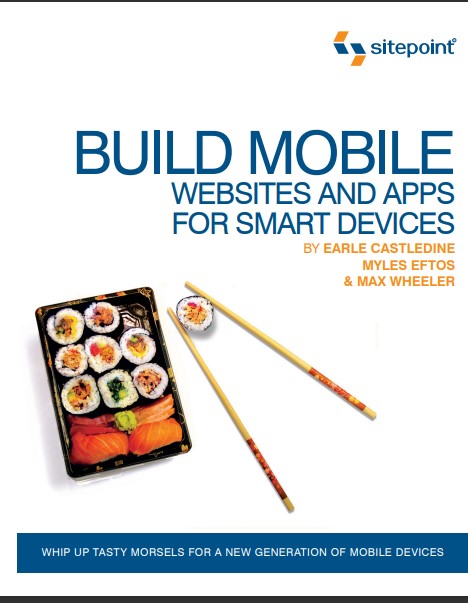BUILD MOBILE
WEBSITES AND APPS FOR SMART DEVICES
WHIP UP TASTY MORSELS FOR A NEW GENERATION OF MOBILE DEVICES
BY EARLE CASTLEDINE
It’s the year 1995, and you’re waiting for an email to download to your state-of-the-art 486 personal computer. Hundreds of megabytes of storage, 16 megabytes of memory, and 256 glorious colors on screen. Suddenly, there’s a flash of light in the corner of the room, and You—from the future—appear in a time machine.
Future You emerges from the mist, and slowly hands you a slick, handheld device. Your eyes widen as you gaze upon the high-resolution display panel. This is your internet now: always on, always with you. High-bandwidth, beautifully smooth animations, stunning visual effects. No tags.
The Web (or at least, our experience of it) has been slowly but steadily evolving and improving since it hit mainstream consciousness late last century. However, the last few years have seen a revolutionary shift in how we consume—and produce—information: the mobile web. It’s more than a “smaller,” portable web—it’s a fundamental change in how people interact with each other and with your products. Mobile device ubiquity, combined with the openness of the Web, have sparked the imaginations of both consumers and inventors.
The benefits of the old Web are still with us. We can buy tickets or pay bills … only now we can do it on the train, or in the bathroom! But even more interesting are the new possibilities opening up to us. When we combine today’s hardware with the funky new HTML5 APIs (and some good ol’ fashion web know-how), we can start to mash up the Internet with our real lives—merging the Web with our immediate surroundings, having relevant data in the palm of our hand when we need it most, and being able to contribute responses and feedback instantly.
Throughout this book, we’ll learn how to make the transition from a clunky old website (you know we still love you!) to a shiny, sexy, mobile site. We will then look at the fine art of app-ifying our sites to behave like a mobile application, by integrating some of the fantastic HTML5 APIs that are becoming available to us: geolocation, local storage, accelerometers, and more. And finally, we take our web applications head-to-head with the big guys: bridging the gap between the open Web and the seductive (and potentially lucrative) world of the native application.
At the end of the book, you’ll not only have the skills to create mobile web applications—you’ll have become part of the most exciting and important development in computing since the Internet itself: the mobile web. A field filled with futuristic geolocatable, gyroscope-enabled gadgets that get cooler every day—a field where the best ideas and most innovative applications are still in the future … it’s just up to us to invent them!
Who Should Read This Book
This book is aimed at web developers who want to learn how to build sites and apps that take advantage of the functionality available in the latest generation of mobile devices, including smart phones and tablets. You should already have intermediate knowledge of HTML, CSS, and JavaScript, as we won’t be spending any time covering the basics of those topics; instead, we’ll be focusing on what’s relevant for the mobile context. It will include some HTML5 and CSS3, but don’t worry if you’re unfamiliar with these new standards—anything we use that’s either new or uncommon will be explained in greater detail.
What’s in This Book
This book features eight chapters and one appendix. Most chapters follow on from each other, so you’re more likely to benefit from reading them in sequence. Feel free to skip sections, though, if you only need a refresher on a particular topic.
Chapter 1: Introduction to Mobile Web Design
We’ll start by covering what designing for mobile devices means. You’ll be guided through the process of designing and building a mobile web application, including what needs to be considered when producing for a mobile context. Although we’ll focus primarily on designing for smartphones, much of the advice provided can apply to any form of mobile device.
Chapter 2: Design for Mobile
Naturally, we want to deliver the best content and experience to our users, but what’s key for mobile applications is the context in which users will access that information. In this chapter, we’ll address how this influences our role as web developers and designers, and what changes we need to make.
Chapter 3: Markup for Mobile
In this chapter, we’ll focus on the HTML5 and CSS3 features we’ll employ to create mobile web apps using standards-based web development techniques. A page with well-structured HTML and clean markup will display and be usable on any device, be it desktop or mobile.
Chapter 4: Mobile Web Apps
This is where we make our mobile website more interactive by turning it into an application to sell in the app marketplaces. We’ll recreate native behaviors in a web setting, being mindful of our limitations whilst playing up to our strengths—transforming our websites into apps that are fun to use.
Chapter 5: Using Device Features from Web Apps
The rise of the smartphone has brought with it all sorts of advanced features—the functionality of which you’d expect could only be served by the native app. Luckily for us, the speedy implementation by mobile browsers of emerging standards has meant that web apps are gaining ground in functionality. This chapter will explore how we can make the most of event-based APIs interacting with the new hardware.
Chapter 6: Polishing Up Our App
Now that we’ve done the groundwork, it’s time to apply some spit and polish to our app. In this chapter, we’ll explore what’s available to help us manage inconsistencies between web and native applications, in order to refine and produce a scintillating app for the marketplace.
Chapter 7: Introducing PhoneGap
In this chapter, we’ll address how to convert our web app into a native app that can run on several platforms with the help of the PhoneGap framework. We’ll look at installing all the required software to develop for iOS, Android, BlackBerry, and webOS, as well as PhoneGap itself.
Chapter 8: Making Our Application Native
In the final chapter, we unleash our web app into the native environment. We’ll cover what’s involved in customizing our app for each of the main platforms, as well as some necessary tweaks to iron out any inefficiencies that might stop us from gaining marketplace approval. Finally, we’ll look at simulators as we detail the all-important testing process.
Appendix A: Running a Server for Testing
Testing sites on mobile devices can be a little trickier than testing on desktop browsers. In this short appendix, we’ll look at a few simple web servers you can use to deliver pages to your phone from your development machine.
READ MUCH MORE INSIDE…280 Pages
“BUILD MOBILE” $47

Click on the Blue Button Below for Instant Access!
 If for any reason you decided within 30 days that “BUILD MOBILE” isn’t for you, simply notify us by email and we’ll gladly refund your money – no questions asked. That’s our Ironclad Guarantee!
If for any reason you decided within 30 days that “BUILD MOBILE” isn’t for you, simply notify us by email and we’ll gladly refund your money – no questions asked. That’s our Ironclad Guarantee!
![]()
Your name and email will Never be shared, sold, or given to anyone.
We keep our subscriber’s privacy sacred. We do not sell or rent your personal information to other parties. What’s more you can always unsubscribe at any time!
Regards, Coyalita Linville
Copyright © 2021 – 2024 U.S.A. Ads Coyalitalinville.com All Rights Reserved Privacy Policy – Earnings Disclaimer – Terms of Use – Contact Us
